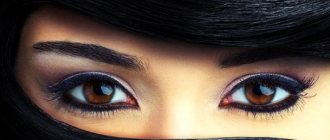Adviсe
- Physiology of color perception
- Psychology of color perception
- Luscher color test
- Brief meaning of card positions
- The meaning of eight colors
- Blue color
- Green color
- Red color
- Yellow
- Purple
- Brown color
- Black color
- Grey colour
“There are no comrades according to taste,” says a common phrase. Have you ever wondered why this happens? What is visual perception related to? What secrets of the human psyche are hidden behind banal color preferences?
Physiology of color perception
The ability to distinguish colors is not inherent in us from birth. A newborn baby has contrast vision: he distinguishes between light and dark. The next stage is noticing movements, then shapes and outlines, and lastly, beginning to distinguish colors.
Getting on the receptors of the eye retina - cones (responsible for color and black-and-white vision) and rods (responsible for black-and-white vision), color photons cause their excitation and inhibition, thus transmitting information to the brain.
The retinal receptors responsible for color vision (cones) in humans and primates have a certain type of light-sensitive pigment that allows them to distinguish colors:
- blue;
- red;
- green.
Thomas Young experimentally showed at the beginning of the 19th century that all visible colors of the spectrum can be obtained by mixing these three colors.
The physiology of color perception is associated with the higher and primitive areas of activity of the cerebral cortex. The functions of perception, discrimination and the ability to name colors are the results of human development, and not instinctive reactions, and are therefore controlled by the higher areas of the cerebral cortex. Primitive areas of the brain control reflex reactions to color (light and dark).
Color topology
There have been debates around color perception in psychology for several centuries. In the 19th century, I. Goethe argued with I. Newton; in the 19th century, G. Helmholtz rejected the ideas of E. Goering.
Today there are also opposing views. Although in general everyone recognized that in the perception of color, the dominant role is played by physical, physiological and psychological characteristics, and not by the actual manifestations of colors.
From the point of view of physics, colors (see figure) are waves of different lengths of the visible light spectrum (from 380 to 780 nm). The order of colors is usually represented in a circular form (the so-called color wheel).
Color circle
This scaling with equal distances forms the Ostwald color system (for the USA - the Munsel atlas). These topologies (the study of place) of colors are also important for psychology. Thanks to the similarity at the beginning and end of the spectral band, they are connected into a chromatic circle (for this, a conditional purple color has been added, which connects the extreme spectral colors).
In human physiology, special light receptors—the cones of the retina—are responsible for the perception of colors (while the rods are responsible for black-and-white vision). Visual processing occurs in retinal neurons. The three types of cones are unevenly distributed and have different degrees of perception of different ranges of the visible spectrum. For longer wavelengths, yellow-green and yellow-red receptors dominate; for shorter wavelengths, blue receptors dominate. Nerve cells connected to the retina reduce (without loss of information) a 3-channel system to a 2-channel system (for the sake of increasing processing speed).
These two channels cybernetically give four color properties: red-green on one channel, yellow-blue on the other (the phenomenon of contrasting colors is associated with this). Both channels interact. The red-green channel perceives waves up to 655 nm, blue-yellow - up to 575 nm.
Along with the disadvantages, the big advantage of such a system is that we can combine mixed light into 128 shades of color.
There are tetrachromats in the world - people with the fourth type of cones who distinguish a mixture of red and green. Thanks to this, they are able to see radiation that goes beyond the spectrum perceived by the human eye and distinguish shades that an ordinary person sees as identical. For example, a purple hue that is not found in the standard physical spectrum.
Psychology of color perception
Color perception is biased, since the preference for one color or another is influenced by many factors:
- age;
- life experience;
- profession;
- health status;
- place and living conditions;
- mental condition;
- belonging to a certain culture;
- brightness, saturation, color change rate;
- background color, neighboring objects, lighting.
In each specific situation, be it the choice of the color of an outfit, interior, car, we are guided by additional factors: whether the outfit will be in harmony with other details of clothing, whether the color of the interior matches the residential purpose of the room, and so on. The choice is entirely conditional.
Disputes about which color is better are meaningless, since each individual perceives colors through the prism of their own subjective experience. To make it clear why this happens, let us turn to the origins of the origin of humanity. Then two factors were decisive for life on earth: day and night, light and darkness. At night, a person stopped engaging in vigorous activity and instinctively devoted this time to rest, sleep, and recuperation. All processes in the body, in particular the work of the endocrine glands, slowed down. The day brought with it the opportunity for active action (getting food, building a home). Metabolism, the work of glands intensified, the influx of energy pushed me to take active action.
Sympathy for a particular color is determined by the characteristics of the brain and the functioning of body systems at a certain period of life.
To make it clear what meaning each color has, which reflects favor towards some colors and rejection of others, let us turn to the research of Swiss psychologist Max Lüscher.
Psychology of human color perception
All material objects in the world around us have their own characteristics, one of which is their color. It carries information necessary for communication and is perceived as a sensory impression. However, this perception is subjective, as it is formed only in the brain of the beholder. The sensation of color is created when waves of a certain length predominate in the color. For example, if the grass is green. This means that from the entire wave range it reflects the waves of the green part of the spectrum, and absorbs the rest. If the intensity of all waves is the same, then the color is perceived as white or gray. Non-emitting waves - black.
Color science (coloristics) is the science of color, studying its nature, characteristics, mixing, harmony, culture, human perception, etc. The first to create a color system was Leonardo Da Vinci, he identified 6 primary colors: white, black, yellow, red, blue, green. One of the aspects of coloristics is the study of human psychological perception of color. Why does red mean “stop” and green “go”. Color affects human physiology and psychology, so it can be used to evoke a particular emotion. So the red “stop” has a stimulating effect on the brain, since it has the longest wavelength, which requires more energy. With green or blue it’s the opposite. Soft, pastel colors evoke a feeling of calm when bright ones irritate.
The perception of color can often change depending on the psychophysiological state of a person. For example, they will decrease if the observer is tired, or, on the contrary, increase in case of danger. The table below provides a brief description of color associations and how color can affect a person.
Figure 1. Scheme of emotional perception of color shades
Table 1. Color associations, color perception
| Color | Associations | Impact |
| White | Purity, innocence, neutrality, lightness. | Increases space and, when used over a large area, creates a feeling of sterility. |
| Black | Mystery, anonymity, depth, mourning. | Conveys depth, can act depressively. |
| Yellow | Friendliness, cheerfulness, energy. | Helps solve problems and problems, stimulates the brain. |
| Red | Energy, speed, love, aggression, danger, fire, blood, war. | Improves mood, excites, leads. |
| Blue, light blue | Ice, sea, sky, depression, fidelity, peace, calm, stability, purity, safety, truth. | Coolness relieves inflammation, reduces anxiety levels; if exposed to it for too long, fatigue and tiredness occur. |
| Green | Nature, health, peace, envy, failure. | Calms the nervous system, reduces fatigue, and concentrates attention. |
| Orange | Warmth, confidence, light. | It has a beneficial effect on performance; prolonged exposure to orange may cause fatigue. |
| Brown | Earth, hearth, stability. | Creates an atmosphere of comfort and safety, conducive to communication. |
It is worth considering that in the culture of different peoples, the emotional and applied perception of color is very different, and is associated with a long historical tradition within the relatively isolated development of an ethnic group and religion. Hence the difference in perception, for example, of white and black colors (mourning or joy - depending on culture, religion).
Color is also very important in the interior. For example, red is good for a dining room, as it increases appetite, and in an office with a predominance of blue tones it will be better to focus attention.
Figure 2. The most suitable colors for different rooms
Colors can also visually change the perception of interior surfaces. In small rooms, it is recommended to make the walls in light colors in order to visually enlarge them. Bright or dark colors in this case will put pressure on a person; it is more rational to use them in large rooms or to highlight separate functional areas.
But a light floor, regardless of the room, will create the effect of less stability and reliability than a dark one.
The table below breaks down the emotional perception of individual colors of the planes of the room.
Table 2. Emotional perception of color in the interior
| Colors | Surfaces | ||
| Ceiling | Walls | Floor | |
| Beige, pink, light yellow | excite | Create a feeling of warmth and visually narrow the space | Causes a feeling of unsteadiness, fragility, unreliability |
| Red, brown, yellow-green | Depresses, makes you feel lonely | Narrow the space | Produces a feeling of stability and security |
| Blue, light green, light gray | Create a feeling of light and height | Spacious, cool | Anxiety, uncertainty, appear slippery, unstable |
| Grey, blue, dark green | Depressing | Causes a feeling of alienation, cools emotions | Creates a feeling of coolness and stability |
Knowledge about the perception of colors is actively used in marketing and advertising. When creating a logo for a particular product, it is necessary, first of all, to interest the future client. In addition, the designer must determine exactly what emotions the image he has developed will evoke in a person. For example, if we are creating a logo for dolls for girls, then pink will certainly be the winning color, as it combines sweetness and fairytale. Or a logo idea for a diner - yellow would be a good color option as it has a fun and friendly feel to it. Such a place will feel cozy and warm, and will undoubtedly provide a large flow of customers.
Figure 3. The influence of color on a person in marketing and advertising
Thus, we can conclude that colors not only make life brighter, but also influence our thoughts and actions, determining our mood. Knowledge about the perception of colors can be rationally used in marketing, design, psychology (to determine the type of person). Based on the above, let's summarize - flowers have their own system, which was consciously noticed by man many centuries ago. As a result, a whole science of color has emerged. From infancy, a person learns color perception, which subsequently depends on the personal characteristics of the individual. Culture plays an important role in the perception of color, as well as many other factors.
Luscher color test
Psychologist Max Luscher studied the phenomenon of visual perception for a long time. As a result, data were obtained on the direct relationship between the psychological state of an individual and the most preferred colors. Luscher created a unique method of color diagnostics. It was called the Luscher test.
Let's talk in general terms about a simplified, but quite informative, version of the test.
The test is carried out by laying out cards painted in eight different colors according to the principle of decreasing liking for colors. The cards are assigned serial numbers:
- primary colors : blue (1), green (2), red (3), yellow (4);
- auxiliary : purple (5), brown (6), black (7), gray (0).
When taking the test, you need to distract yourself from the relationship of colors with each other. Perceive only the color itself abstractly, without any assessments, do not think about whether you like clothes of this color, whether similar tones are acceptable in the interior.
This procedure is carried out twice. When making a choice a second time, you don’t need to think or remember which tones were chosen earlier. This will result in two rows of numbers that need to be written down in order of preference. Based on the data obtained during the test, a person receives a comprehensive analysis of his personal psychological state.
Interestingly, the Luscher color test is sometimes used as an auxiliary diagnostic method when making a medical diagnosis; it can warn of the occurrence of painful conditions: heart failure, compression of cerebral vessels, malfunctions of the gastrointestinal tract.
The objectivity of the test is determined by the perception of color through contrasts. So, if the body is subject to excessive stress, needs peace, tranquility, emotional and physical rest, stress relief, the choice will instinctively fall on darker colors. If there is a desire for energetic activity, creativity, the result of the choice will be brighter tones.
Colorblindness (the inability to distinguish one or more colors) does not prevent you from taking the test and obtaining reliable results.
The colors for the test were carefully selected based on psychological and physiological meaning. This data is universal for any person. The main condition is a clear understanding of how the diagnosis is carried out: the subject must arrange the colored cards in order of their preference on an intuitive level.
Interpretation of test results is carried out based on the transcript:
- place (order) of each card;
- the meanings of the selected colors;
- values of the color ratio in pairs of cards that are in the same position for each choice (for example,
- with the first choice, green took the leading place, and with the second, yellow).
People taking the test are often shocked that simply laying out colorful cards can reveal such a deep psychological state.
What is color
Color is the subjective perception by the human brain of visible light, the differences in its spectral structure perceived by the eye. Humans have a better ability to distinguish colors than other mammals.
Light affects the photosensitive receptors in the retina, which then produce a signal that is transmitted to the brain. It turns out that the perception of color is formed in a complex way in the chain: the eye (neural networks of the retina and exteroceptors) – visual images of the brain.
Thus, color is an interpretation of the surrounding world in the human mind, arising as a result of processing signals coming from the light-sensitive cells of the eye - cones and rods. In this case, the former are responsible for the perception of color, and the latter are responsible for the acuity of twilight vision.
Brief meaning of card positions
The color of the very first card in each row means the method of moving towards the goal, the state in which a person strives to achieve what he wants. For example, if the color blue comes first, then the main method is peace and tranquility.
The second position is the true goal, what a person strives for.
The third and fourth places reflect the situation and circumstances of the current period of life at the time of testing.
The fifth and sixth cards represent indifference; their meaning is not rejected, but has no place in the current situation.
The seventh and eighth are hostility, rejection, antipathy, forcedly suppressed needs.
The meaning of eight colors
Each of the eight colors has a specific meaning; below are brief characteristics.
Blue color
This color symbolizes the depth of feelings, peace, and concentration. People who choose blue are sensitive, receptive, and want integrity. They care about love, tenderness, and mutual affection. This is the color of fidelity, it promotes philosophical reflection and concentration. It’s not for nothing that you can endlessly look at the sea. Rejection of the color blue indicates unsatisfied emotional needs and a suppressed desire for peace.
Green color
Green indicates flexibility of mind. Its psychological components: stubbornness, perseverance, resistance to change, self-confidence. People who choose green are firm in their opinions and true to their principles. It is important for them to strengthen their own importance, self-respect, and dominance over others.
Red color
This color symbolizes willpower, blood, fire, masculinity. Embodies desires, passionate aspirations. Has a stimulating effect on the nervous system. Raises blood pressure, enhances the functioning of the endocrine system.
Rejection of red expresses irritation from a lack of vital energy, hostility to excited activity. This may be due to physical weakness, fatigue or heart failure.
Yellow
Yellow color is spontaneity, spontaneity, a source of bright joy and cheerful optimism. Those who prefer yellow tend to strive for happiness, hope, and impulsiveness. The expectation of happiness manifests itself in various forms: from intimate adventure to spiritual quests that culminate in enlightenment. If the yellow color is denied, then this is a clear indication that hopes and desires have collapsed, and the person feels alienated.
Purple
Purple color is a combination of red and blue. Presented as a separate color that combines the impulsive passion of red and the deep tranquility of blue. A person who likes the color purple believes in miracles, expects magic, wants to make impressions, wants to evoke admiration. Preserves childlike spontaneity into adulthood. It is not for nothing that after babies learn to distinguish colors, they choose purple from the multi-colored toys offered to choose from.
Brown color
This color signifies the importance of physical perception. The choice of brown indicates that a person has certain physical ailments, problems, the inability to ensure his own safety, and a feeling of anxiety. There is a desire to get rid of problems that cause physical discomfort.
When the Luscher test was administered to people who had gone through the war, most of them preferred brown due to psychological decline and health problems.
Black color
Black embodies the rejection of color. Black color is “no”, the cessation of life, destruction. People who put black first on the list of their preferences reject everything, protest, proclaim that they are not satisfied with the established order of things. Rebellion is their way of life. Here it is appropriate to recall the movement called “goths”, who deny rules and conventions, dress in black, and do not recognize other colors.
Grey colour
This color symbolizes neutrality. It is neither light nor dark, neither bright nor pale. He is nobody's, psychologically neutral. People who have chosen the gray color and put it first want to protect themselves from the outside world, want no one to interfere in their lives. When solving their own problems, they take an observant position.
The psychology of perception is a subtle, complex, but incredibly interesting science. External sense organs receive signals from outside and send them to the brain. The brain at the reflex level (automatically) correlates received signals with the internal state of the body, processes information, and produces results. Thus, knowing what colors a person likes, you can easily analyze not only his internal psychological state, but also his physical health.
Human color perception
If we look around, we will see not only the shape of the surrounding objects, but also different colors. Physicists define color as a wavelength in the electromagnetic range, i.e. The color of an object is a certain objective fact, the ability of an object to absorb and emit light waves.
We distinguish colors thanks to special cells on the retina of the eye, which capture radiation in the optical range and transmit the signal to the brain, where a “picture” of the object appears. In humans, there are three types of such cells that perceive the blue, green and red parts of the light spectrum. Therefore, all the colors that we see consist of the sum of the sensations of these three colors.
It would seem that color is some kind of objective fact, a physical phenomenon. However, different colors have different effects on the physical and psychological state of a person. Human color perception is a complex of different processes. The psychology of color perception studies these relationships .
Article navigation: “Psychology of color perception: how to use color to improve your mood?”
- Mood and color
- If everything seems gray
- Listen to yourself
- Let's look for color in fruits and vegetables
- Art therapy
- Nature around us
- Small steps - every day
For example, researchers talk about human genetic memory. For thousands of years, red has been associated with fire, the color of blood, green with the surrounding nature, foliage, blue with sky, water, etc. So, gradually the colors began to carry a subconscious message: red - danger, activity, green - peace, development, blue - calm, space.
The physiological effect of colors has also been proven at the experimental level: red color excites the nervous system, causing increased respiration and heart rate. Blue color, on the contrary, has an inhibitory effect on our nervous system. The visual pathways in the brain are anatomically connected to various brain structures responsible for the activation and inhibition of the nervous system, the state of blood flow, and muscle tone.









